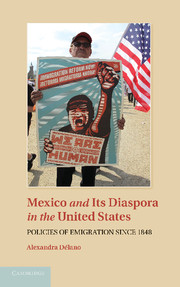Book contents
- Frontmatter
- Contents
- Acknowledgments
- Map
- Introduction
- 1 The Mexican State's Interests
- HISTORICAL BACKGROUND
- FROM LIMITED ENGAGEMENT TO ACTIVE EMIGRATION POLICIES (1982–2006)
- 4 From a Policy of Having No Policy to a Nation beyond Mexico's Borders (1982–2000)
- 5 The Migration Agreement (2000–2003)
- 6 Institutionalizing State–Diaspora Relations (2003–2006)
- Conclusions
- Bibliography
- Index
5 - The Migration Agreement (2000–2003)
Published online by Cambridge University Press: 05 July 2011
- Frontmatter
- Contents
- Acknowledgments
- Map
- Introduction
- 1 The Mexican State's Interests
- HISTORICAL BACKGROUND
- FROM LIMITED ENGAGEMENT TO ACTIVE EMIGRATION POLICIES (1982–2006)
- 4 From a Policy of Having No Policy to a Nation beyond Mexico's Borders (1982–2000)
- 5 The Migration Agreement (2000–2003)
- 6 Institutionalizing State–Diaspora Relations (2003–2006)
- Conclusions
- Bibliography
- Index
Summary
Many people in Mexico still consider that the migration phenomenon contributes so much to Mexico (particularly through the astronomic amount of remittances) that it's better not to touch it. It is a source of income. It is a safety valve to unemployment. What are the costs of the deaths at the border in comparison to migrants' contributions to the country? A profound debate on these issues has not yet taken place in Mexico.
– Interview with Andrés Rozental, former Mexican Undersecretary for North American Affairs, February 12, 2005One of the most significant and controversial changes promoted by Vicente Fox's government (2000–2006) was the reinterpretation of Mexico's foreign policy. At the beginning of 2001, the Secretary of Foreign Affairs, Jorge G. Castañeda, described the new “axes” on which Mexican foreign policy would be based in order to adapt to the most recent national and international transformations, including the democratization process in Mexico, economic integration with the United States, and the pressures of globalization. This new approach would entail a more active presence in multilateral forums, a consistent defense of human rights at the national and international levels, and deeper integration with the United States, including a more comprehensive bilateral agenda (Castañeda, 2001). In this context, one of the main issues that was actively and explicitly incorporated into the United States–Mexico agenda for the first time was the need to establish broader cooperation mechanisms, including a migration agreement, to face the challenges of a migratory flow of between 400,000 and 500,000 people a year, and the presence of nearly 10 million Mexican migrants in the United States in 2000 (of whom close to 5 million were undocumented migrants at the time; Grieco, 2003).
- Type
- Chapter
- Information
- Mexico and its Diaspora in the United StatesPolicies of Emigration since 1848, pp. 165 - 198Publisher: Cambridge University PressPrint publication year: 2011



